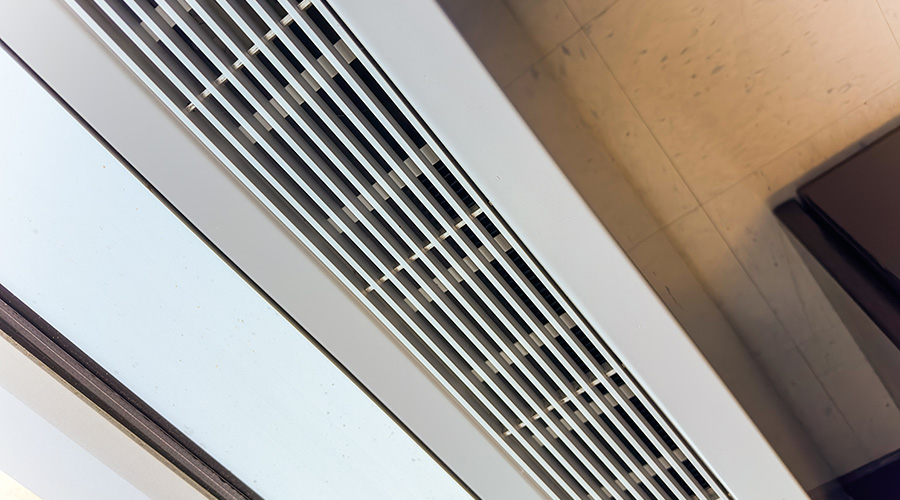IEQ Factors Daylighting, Thermal Comfort and Acoustics for Healthy Space
In recent years, IEQ has emerged as an area of focus, in part because of its place in the U.S. Green Building Council's LEED green building rating system. Not only does indoor environmental quality take into account VOCs and other pollutants, it considers how the entire indoor environment contributes to an occupant's well-being. IEQ is the next iteration of IAQ. "The 'E' in IEQ encompasses a broader range of concerns than just air quality," says Cedro. "It looks at the quality of what contains the air."
There are generally three areas included in IEQ: daylighting, thermal comfort and acoustics.
Daylighting. After decades of closing off buildings from the outside world starting in the mid-1900s, the benefits of daylight and views are becoming more apparent. "As we have built deeper floor-plate buildings and reduced glazing areas in the name of energy conservation, we have begun to realize the consequences of reduced connection to the outdoors," says Robin Guenther, principal at Perkins+Will and principal author of the Green Guide for Health Care.
The benefits of daylighting are supported by science, not just common sense, says Cedro. "Regardless of activity, we've seen that having daylight just produces better well being at all levels, whether you're a student, office worker or shopper." The benefits of daylight on productivity have been measured a number of ways, including absenteeism rates, retail sales and student test scores. Two studies by the Heschong Mahone Group found that workers in a call center were able to process calls 6 to 12 percent faster when they had access to views and daylight vs. no views.
No facility can operate with just daylight alone, however, so it's important to design an electric lighting system that supports occupant productivity as well. Good color rendition and giving occupants an appropriate level of control over the lighting are paramount, says Cedro. Task lighting is a simple way to add controllability. It's rare that one has to sacrifice lighting quality for energy efficiency anymore with new lighting products, he says.
Thermal Comfort. The temperature of a space can have an effect on worker productivity, making it an important part of good IEQ. According to a study by CB Richard Ellis, worker performance increases with temperatures up to 72 degrees F, and decreases when temperatures rise above 73 to 75 degrees F.
Keeping ambient temperatures within that optimal range is important, but all facility managers know that complaints about the temperature will always come, even if they're opposite complaints at exactly the same time. To account for people's varying comfort zones, give occupants a degree of controllability over temperature. That's what research suggests is most important to occupants, says Guenther.
The easiest and most efficient way to provide thermal controllability is with underfloor air distribution systems. "Workplaces with underfloor air distribution provide a high level of thermal comfort to individuals compared to traditional overhead delivery of air," says Guenther. But unless a facility is new or is undergoing a major renovation, underfloor air is probably not realistic. For those situations, Guenther recommends using control systems that permit individual room controls and considering installing operable windows.
In a broader sense, the solution to the problem of providing better thermal comfort and controllability lies in scaling down buildings, says Cedro. "My sense of where we're headed is moving away from very large office spaces in sealed buildings. Given the real estate market, it's difficult to provide the range of thermal comfort people need at an affordable rent."
Acoustics. Besides affecting productivity, poor acoustics can leave occupants irritable, distracted or annoyed, or sometimes even cause headaches or dizziness. In many modern sustainable buildings, some things may work against good acoustics. Open plenum spaces where there used to be acoustic ceilings and more exposed decking and concrete both amplify acoustic problems. Noise from HVAC and other mechanical systems has been a concern for facility managers for years. And now with more operable windows, noise from outside, such as traffic or sirens, plays into the equation as well.
Good acoustics has been shown to reduce fatigue and improve concentration, says Guenther. One way to improve acoustics in an open office setting is with soundmasking. Soundmasking utilizes small speakers, usually placed above the plenum or hanging from an open plenum. Tuned to the right frequencies, soundmasking can give a higher level of speech privacy and make unwanted noise less noticeable without being obtrusive.
Ceilings also play a big role in office acoustics. Most ceiling tiles are made from a sound absorptive material, usually mineral composites or fiberglass. Facility managers should look for ceiling tiles that have a high noise reduction coefficient (.75 or greater) to prevent sound from reflecting back into an open office space.
Facility managers should also use absorptive materials in the space, especially in an open plan office. Adding absorptive acoustic materials, such as fiberglass, in furniture panels is a common way to control sound. Experts warn against using too many absorptive materials, however. "Look to balance the desire for acoustic privacy with some sense of liveliness," says Cedro. "There's an aural quality to every space. The space shouldn't sound dead."
Similarly, look to other materials that go into a space to inject interest and liveliness. Color, texture and materials are all important to human senses. IEQ is about designing an entire interior space that stimulates people and encourages productivity. "A space could have excellent IAQ, but it doesn't inspire anyone," says Cedro. "If a space functions well and stimulates the senses, it will cause good things to happen."
Related Topics:












